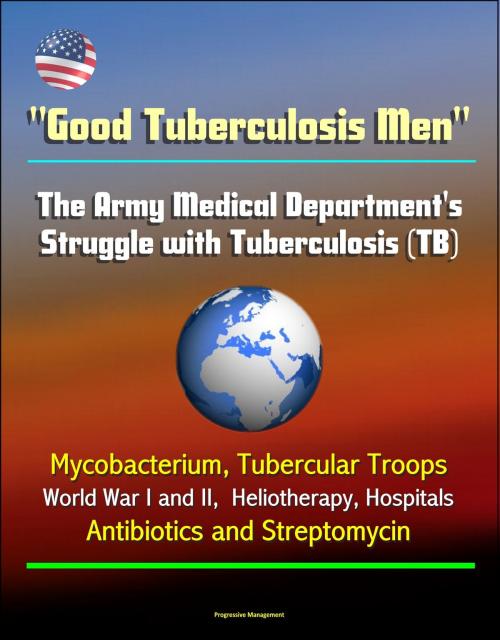"Good Tuberculosis Men": The Army Medical Department's Struggle with Tuberculosis (TB) - Mycobacterium, Tubercular Troops, World War I and II, Heliotherapy, Hospitals, Antibiotics and Streptomycin
Nonfiction, Health & Well Being, Health, Ailments & Diseases, Respiratory, History, Military, United States| Author: | Progressive Management | ISBN: | 9781311739124 |
| Publisher: | Progressive Management | Publication: | December 12, 2015 |
| Imprint: | Smashwords Edition | Language: | English |
| Author: | Progressive Management |
| ISBN: | 9781311739124 |
| Publisher: | Progressive Management |
| Publication: | December 12, 2015 |
| Imprint: | Smashwords Edition |
| Language: | English |
Professionally converted for accurate flowing-text e-book format reproduction, this excellent book by the U.S. Army provides a history of the battle against tuberculosis waged by the Army Medical department from the late 1890s, when it was a ubiquitous presence in society, to the 1960s when it became a curable and controllable disease.
Chapter One - The Early Years: Fort Bayard, New Mexico * Chapter Two - Life at Fort Bayard * Chapter Three - The Congressman as Tuberculosis Patient * Chapter Four - Tuberculosis in World War I * Chapter Five - "A Gigantic Task": Treating and Paying for Tuberculosis in the Interwar Period * Chapter Six - "Good Tuberculosis Women": Tuberculosis Nursing during the Interwar Period * Chapter Seven - Surviving the Great Depression: Fitzsimons and the New Deal * Chapter Eight - Camp Follower: Tuberculosis in World War II * Chapter Nine - Miracle Drugs?
During the past 239 years, our fighting forces have been stopped more often by diseases such as smallpox, cholera, and malaria than by enemy bullets. Our lessons learned in fighting these diseases have never been more important than they are today, because the health and resilience of our men and women in uniform have never been a greater matter of national security. Throughout history, the Army Medical Department has used our past experiences to strengthen our capacity and our resolve as a healthcare organization to support and sustain the Army, enhance the care experience, and innovate Army Medicine.
Tuberculosis is one of the diseases that have incapacitated our fighting forces in the past. "Good Tuberculosis Men: The Army Medical Department's Struggle With Tuberculosis" details the history of the Army's battle with this disease. Carol R. Byerly's extensively researched and insightful publication highlights the adaptability, tenacity, and resourcefulness of Army Medicine in overcoming challenging obstacles in the past.
Early Army tuberculosis programs proved to be effective; tuberculosis dropped from first place among reasons for federal disability discharges after World War I to 13th place after World War II. By the 1960s, tuberculosis became a curable and controllable disease. The US Army Medical Department—as with many infectious diseases—was a leader in the global efforts to contain, control, and cure this disease.
While the prevalence of tuberculosis has decreased dramatically in the Western world, it is still common in other parts of the world where nearly two million people die each year from tuberculosis, and one-third of the world's population is infected. As a result, tuberculosis is a serious threat to our fighting capabilities should American fighting men and women deploy to areas where this disease is still endemic.
Professionally converted for accurate flowing-text e-book format reproduction, this excellent book by the U.S. Army provides a history of the battle against tuberculosis waged by the Army Medical department from the late 1890s, when it was a ubiquitous presence in society, to the 1960s when it became a curable and controllable disease.
Chapter One - The Early Years: Fort Bayard, New Mexico * Chapter Two - Life at Fort Bayard * Chapter Three - The Congressman as Tuberculosis Patient * Chapter Four - Tuberculosis in World War I * Chapter Five - "A Gigantic Task": Treating and Paying for Tuberculosis in the Interwar Period * Chapter Six - "Good Tuberculosis Women": Tuberculosis Nursing during the Interwar Period * Chapter Seven - Surviving the Great Depression: Fitzsimons and the New Deal * Chapter Eight - Camp Follower: Tuberculosis in World War II * Chapter Nine - Miracle Drugs?
During the past 239 years, our fighting forces have been stopped more often by diseases such as smallpox, cholera, and malaria than by enemy bullets. Our lessons learned in fighting these diseases have never been more important than they are today, because the health and resilience of our men and women in uniform have never been a greater matter of national security. Throughout history, the Army Medical Department has used our past experiences to strengthen our capacity and our resolve as a healthcare organization to support and sustain the Army, enhance the care experience, and innovate Army Medicine.
Tuberculosis is one of the diseases that have incapacitated our fighting forces in the past. "Good Tuberculosis Men: The Army Medical Department's Struggle With Tuberculosis" details the history of the Army's battle with this disease. Carol R. Byerly's extensively researched and insightful publication highlights the adaptability, tenacity, and resourcefulness of Army Medicine in overcoming challenging obstacles in the past.
Early Army tuberculosis programs proved to be effective; tuberculosis dropped from first place among reasons for federal disability discharges after World War I to 13th place after World War II. By the 1960s, tuberculosis became a curable and controllable disease. The US Army Medical Department—as with many infectious diseases—was a leader in the global efforts to contain, control, and cure this disease.
While the prevalence of tuberculosis has decreased dramatically in the Western world, it is still common in other parts of the world where nearly two million people die each year from tuberculosis, and one-third of the world's population is infected. As a result, tuberculosis is a serious threat to our fighting capabilities should American fighting men and women deploy to areas where this disease is still endemic.















